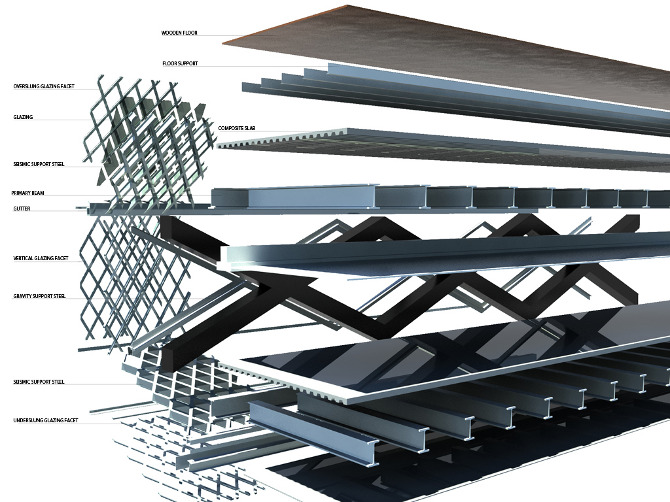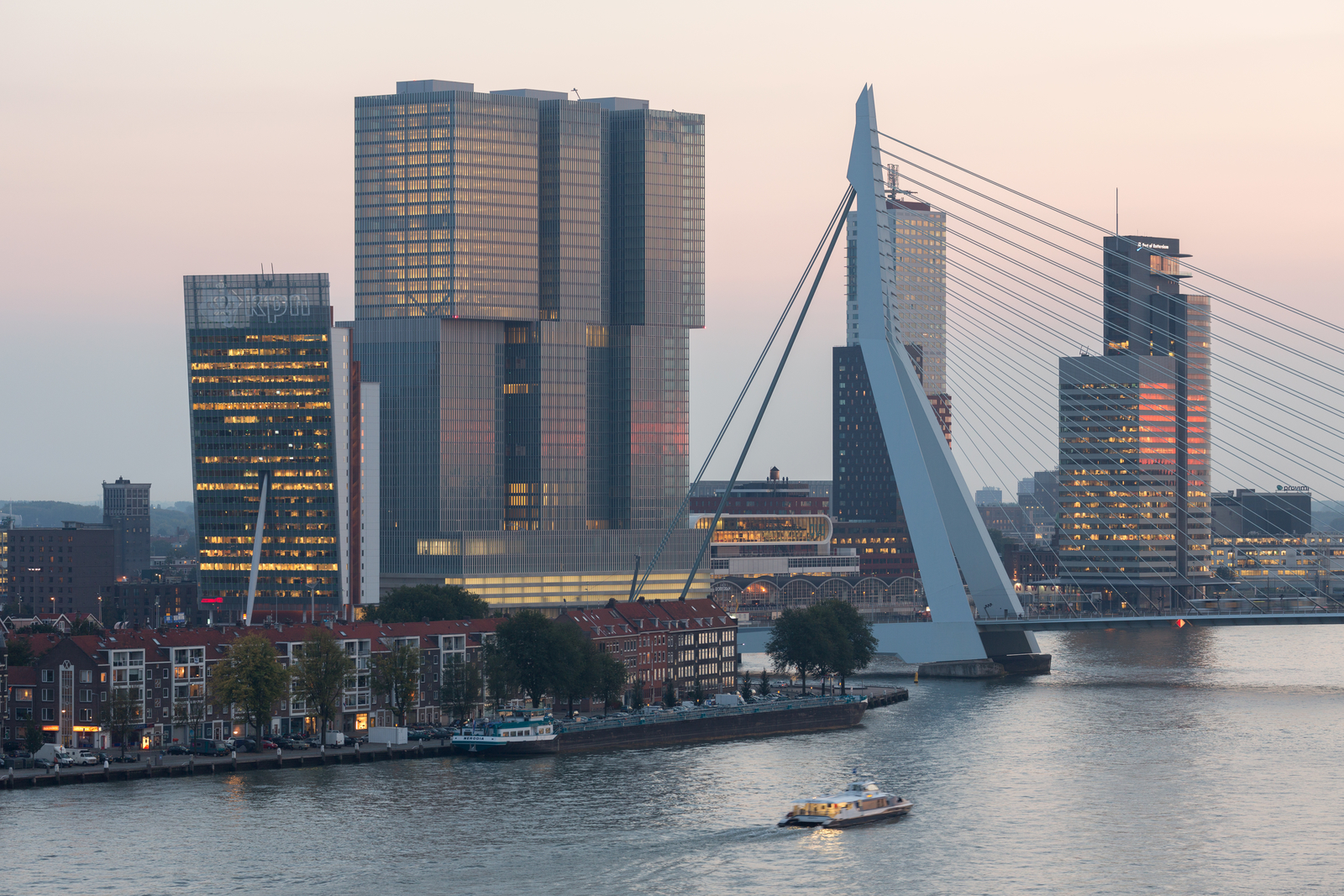Architizer is thrilled to announce that the 2026 A+Product Awards is open for submissions! The clock is ticking — get your products in front of the AEC industry’s most renowned designers by submitting today.
The Office for Metropolitan Architecture (OMA) has transformed how we think about architecture and design. A leading international practice operating across architecture, urbanism and design research, OMA was founded in 1975 by Rem Koolhaas and Elia Zenghelis, along with Madelon Vriesendorp and Zoe Zenghelis, and has since become known for visionary solutions that upend programmatic convention.
Understanding design as a process, OMA is one of many Dutch practices critically testing the relationship between structure, program and building skins. Carefully articulating the conditions between interior and exterior, circulation and boundary, the firm draws out the relationships between interior spaces and the building façade. Exploring OMA’s investigation into envelope and enclosure, the following projects show how the firm approaches the design of the contemporary façade in collaboration with some of the world’s best engineers and glazing manufacturers.


 Rijnstraat 8 by OMA, the Hague, Netherlands
Rijnstraat 8 by OMA, the Hague, Netherlands
As a renewal of the original former Ministry of Housing, Spatial Planning and the Environment building, Rijnstraat 8 was realized through a collaboration between the previous architect, Jan Hoogstad, and Ellen van Loon of OMA. Rijnstraat 8 brings together two ministries and two governmental organizations in a single building with flexible working spaces. Made to form a new relationship to the city, the design centers around a new glass façade that opens up to the surrounding context.
Rijnstraat 8 was created with open plan offices and triple glazing to reduce energy consumption and reveal the building’s internal processes. The resulting series of glazed atriums are positioned between the outer and inner façades, forming a thermal shell that shuts out traffic noise and allows occupant operability. In addition, a series of operable glass roofs allows for natural ventilation.

Detail via Architecture Week


Detail by Eva Poulopoulou
 Seattle Central Library by OMA and REX, Seattle, WA, United States
Seattle Central Library by OMA and REX, Seattle, WA, United States
Façade by Dewhurst Macfarlane & Partners and LMN
One of OMA’s most well-known buildings, the Seattle Central Library has become a celebrated civic and cultural project. Programming was at the project’s heart from the outset, directly shaping the building’s form while combining diverse functions. Built for the circulation of knowledge across different forms of media, the library was designed to present information equally and legibly. It is composed of five platforms and four flowing planes wrapped in a steel diagrid façade.
The building’s glass and metal skin began with the simple concept of wrapping the entire building in a continuous layer of transparency. Made to unify shifting planes of glass, a diamond module system was used for the mullion framing throughout the envelope. The curtain wall glazing system was built with numerous components, from I-beam latticed steel and aluminum splice plates to threaded rod attachments. The façade panels were fabricated entirely in Germany and then shipped to Seattle for installation.

Diagram via Afasia

 Garage Museum of Contemporary Art by OMA, Moscow, Russia
Garage Museum of Contemporary Art by OMA, Moscow, Russia
Façade by Werner Sobek
A dramatic renovation of the 1960’s restaurant on site, the Garage Museum is a center for contemporary art in Moscow. The museum program includes galleries, a shop, café, roof terrace, auditorium and offices. A new translucent polycarbonate façade wraps the original structural framework and is lifted off the ground, allowing views between Gorky park and the exhibition space inside.
The Garage Museum’s existing concrete structure was enclosed with a double layer façade to accommodate a large portion of the building’s ventilation equipment and create a separate volume of space for intervention. The envelope and the spaces it encloses offer a range of interior conditions for the exhibition of art and provides innovative curatorial possibilities, such as hinged white walls that can be folded down from the ceiling.


 Timmerhuis by OMA, Rotterdam, Netherlands
Timmerhuis by OMA, Rotterdam, Netherlands
Façade by Scheldebouw, Rollecate
OMA’s Timmerhuis project was designed as a new municipal building for the city hall that combines residential and administration space. Formed as modular units that work within an innovative structural system, the building was designed to be the most sustainable building in the Netherlands. OMA accomplished this through the building’s core concept of flexibility, and also through the two large atriums that act like lungs. The cantilevering steel structure allows for an uninterrupted public space on the ground floor that unfolds through the building.
For the enclosure, the building’s triple glazed curtain wall façade uses hi-tech translucent insulation that allows for unprecedented energy efficiency. This surface strategy combines with the Timmerhuis massing to mediate between the surrounding existing buildings. Through the modular system, units can adapt to either office space or residential parameters, and green terraces on higher levels of the envelope provide the possibility of an apartment with a garden in the heart of urban Rotterdam.

Detail via AEC Cafe

 De Rotterdam by OMA, Rotterdam, Netherlands
De Rotterdam by OMA, Rotterdam, Netherlands
Façades by Permasteelisa and TGM
Standing as the largest building in the Netherlands, OMA’s De Rotterdam project explored urban diversity and density through three monumental towers joined by a shared plinth. Made with subtly irregular stacks, the design organizes program into distinct blocks that embrace a wide variety of uses. Formed around the idea of a vertical city, the project has 1.7 million square feet of utilizable floor space along the port area district.
The building envelope was designed with floor-to-ceiling glass windows overlooking the River Maas. De Rotterdam’s external façades have been clad with an aluminum post-and-beam construction, making for a filigree appearance which changes depending on the viewer’s position. This provides the complex with a unifying compact shell.
Architizer is thrilled to announce that the 2026 A+Product Awards is open for submissions! The clock is ticking — get your products in front of the AEC industry’s most renowned designers by submitting today.
 ARUP
ARUP  De Rotterdam
De Rotterdam  Garage Museum of Contemporary Art
Garage Museum of Contemporary Art  Seattle Central Library
Seattle Central Library  Timmerhuis
Timmerhuis 


